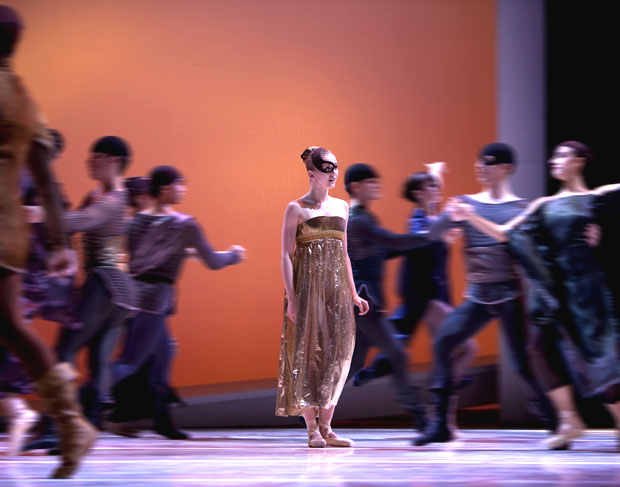
© Angela Sterling & courtesy of Pacific Northwest Ballet. (Click image for larger version)
Pacific Northwest Ballet
Roméo et Juliette
New York, City Center
16 February 2013
www.pnb.org
www.nycitycenter.org
Star-Crossed
What have we learned about Pacific Northwest Ballet during the company’s too-brief New York season? Firstly, that we’d like to see them again, sooner rather than later, and preferably in a broader range of repertoire. That it is a company of strong, limpid, slightly reticent dancers, and from the looks of it, quite versatile as well. That it is backed by an excellent musical ensemble, led by principal conductor Emil de Cou. And that Peter Boal, its director, has nurtured in its midst the blossoming of utterly captivating ballerina, Carla Körbes (interview). Without Körbes’s natural, radiant dancing, Jean-Christophe Maillot’s Roméo et Juliette, which dominated the company’s four-day run, would have been hard to bear. As it was, it was a stretch.
Maillot is French; since 1993 he has directed the Ballets de Monte Carlo. Last year, that company came to New York with a program of his dances. None was particularly distinguished, but all exhibited a knowing stylishness that appears to be one of his defining qualities as a choreographer. His Roméo et Juliette, set to Prokofiev’s familiar, sweeping score, exudes a similar whiff of chic. (It was originally made for his home company, in 1996; a group of Maillot’s collaborators, led by his first Juliet, Bernice Coppieters, set the ballet on PNB in 2008.) The costumes, by Jérôme Kaplan, are elegant, refined and well-cut, in delicate earth tones, with fabrics that are both diaphanous and structured, allowing freedom of movement while caressing and flattering the body. The costumes for the men, blocky knits over tights, are not bad either; Romeo’s off-white tunic is very attractive indeed. The sets are minimal, with white panels and ramps that shift from scene to scene to facilitate entrances and exits. (If only the ramp did not sway quite so much.) The configurations are nice to look at, easily adaptable. The lighting, too, is extraordinarily flattering, bright and warm.

© Angela Sterling & courtesy of Pacific Northwest Ballet. (Click image for larger version)
But Maillot’s minimalist esthetic does not extend to his storytelling or choreographic impulses. In fact, he indulges in a style that is both unspecific and overwrought, exaggerated and over-symbolic. On the one hand he pares down the story, eliminating volumes of detail and erasing various characters, including Juliet’s father and the Prince of Verona. Certain roles, like that of Paris are so reduced that the dancer (Joshua Grant) is left with almost nothing to do. On the other, Maillot overlays the action with heavy symbolism and repetition, pads it with hammy, mawkish humor, and loads it down with an intrusive subplot. You see, the story is told from Friar Laurence’s point of view, as a guilt-laden flashback. The good monk (William Lin-Yee) skulks around in every scene (including the bedroom), bending into twisted shapes and wringing his hands; he is the first character we see, and the last one standing. There is even a slight suggestion that he and Juliet might have a romantic bond beyond that of a young girl and her confessor. He holds her hand in her deathbed.
Furthermore, the ballet is laced with repetitive motifs that do nothing to advance the plot or provide insight into the interior lives of the characters. Do we really need not one but two foreshadowings of Romeo’s death? And two scenes in which Juliet’s nurse is squeezed and prodded by Romeo’s friends? All this is hammered home with great emphasis; no emotion is left un-amplified. Mercutio – the droll Jonathan Porretta – mugs shamelessly. Madame Capulet – the strong, leggy Maria Chapman – is a crazed, vamping Cruella De Vil. The silent screams come hard and fast. And did I mention the slow-motion fight-scene, complete with crazed eyes and punches to the gut, like a brawl out of Gangs of New York? It takes a lot to make Kenneth MacMillan look understated.

© Angela Sterling & courtesy of Pacific Northwest Ballet. (Click image for larger version)
Then there is the weird fixation with breasts. As in every version of the ballet, Juliet’s first scene takes place in her bedroom, where she is trying on her party dress. In the process, she discovers that her body is changing. Maillot feels the need to make this self-discovery even more explicit: she pulls her dress down to her waist (with her back to the audience) whereupon her nurse gawks at her budding figure. Got it? Then she looks under her blouse, just to make sure. Not to mention the constant fondling; whether they’re in the main square or at the Capulet ball, the men always find time for a good squeeze. Death, too, proves no barrier.
Meanwhile, Maillot’s dance vocabulary provides little respite. Neither descriptive nor satisfying on its own terms, the choreography in his Roméo consists of an endless series of starts and stops. Jerky, slashing arm movements interrupt lyrical phrases; expansive passages are intercut with angular shapes and Graham-like contractions, ornamented with busy hand gestures. The partnering is choppy, with lots of tapping and jabbing and dragging across the floor. No movement idea is ever developed, though repetition abounds. Laurence shuffles and bends; Madame Capulet kicks and slashes the air; Romeo and his friends cartwheel and skip-jump or revert to balletic steps like brisés and ballonnés and turns with the leg extended to the side.
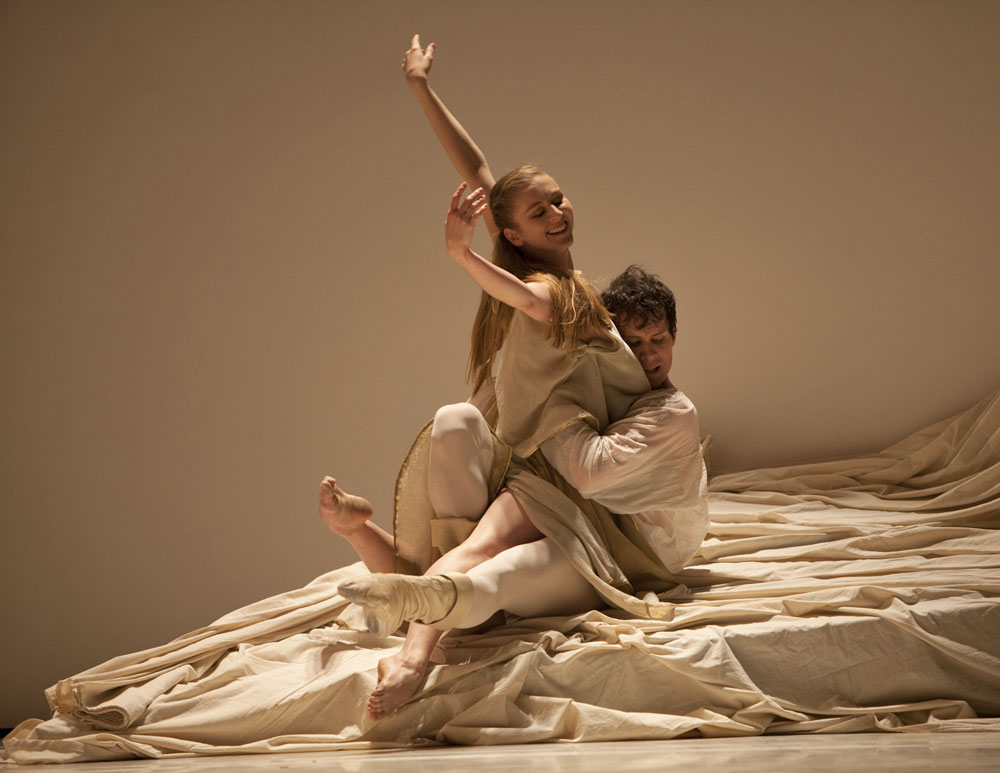
© Angela Sterling. (Click image for larger version)
And yet, the ballet somehow manages to create an effect. People are moved. How does it accomplish this? The answer is quite simple: the company dances it well, with a full-bodied commitment that communicates genuine emotion. They are lovely dancers. The honesty of their execution, aided by the shimmering, lyrical playing of the company orchestra, manages to save the ballet from itself. In the end, Prokofiev’s cinematic score always wins, because it tells you exactly what to feel. And who is not moved by the story of Romeo and Juliet? Especially as danced by the likes of Carla Körbes and Seth Orza, touchingly direct, un-histrionic dancers who are also wonderfully in tune with each other. When Körbes is onstage, one can almost forget the silliness of the choreography and simply lose oneself in the character she creates, the rush of emotions on her face and in her body, her skittering steps, and the almost voluptuous expansiveness of her movement. A single step sticks in my mind: a lush unfurling of her leg while standing on the tip of one bare foot, head thrown back, arms open. The abandon, beauty, and sheer physical joy of that image speaks for itself. I may not want to see Maillot’s Roméo et Juliette again, but these dancers are welcome back anytime.













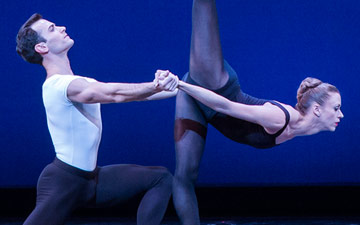
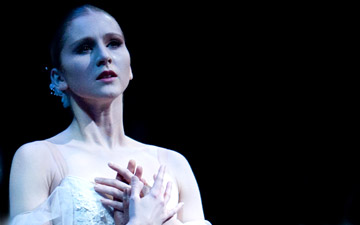
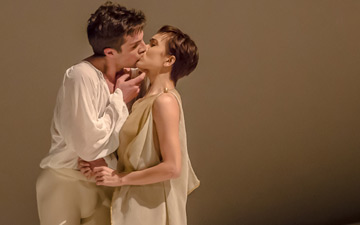
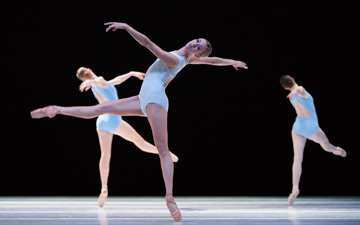
You must be logged in to post a comment.